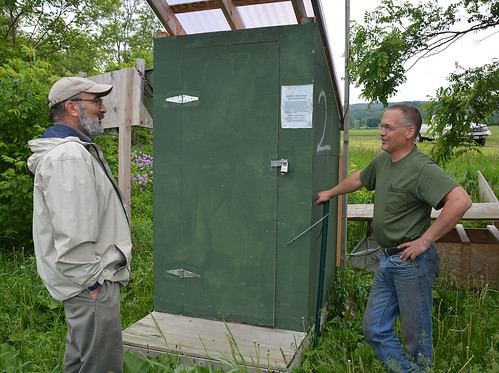By Amy Overstreet

NRCS Soil Conservationist Danny Peet, left, worked with Vermont farmer Lorenzo Whitcomb to implement edge-of-field water quality monitoring in an effort to minimize impacts to water quality from agricultural runoff. - See more at: http://blogs.usda.gov/2015/07/23/technology-enables-vermont-dairy-farmer-to-measure-positive-impacts-of-conservation/#sthash.ZZ4JmWAK.dpuf
NRCS Soil Conservationist Danny Peet, left, worked with Vermont farmer Lorenzo Whitcomb to implement edge-of-field water quality monitoring in an effort to minimize impacts to water quality from agricultural runoff.
Stewardship and cutting-edge technology are nothing new to the North Williston Cattle Company, a Vermont dairy farm that uses solar energy and robotic milking machines. The latest advancement on the 800-acre, 224-head operation are edge-of-field water quality monitoring stations, which measure water quality and the benefits of using conservation practices on the dairy farm.
Lorenzo Whitcomb, one of the managers of the family-run dairy, worked with USDA’s Natural Resources Conservation Service (NRCS) to install the monitoring stations. NRCS has made technical and financial assistance available to farmers in key watersheds across the country.
“The results from this study will illustrate to farmers more precisely the real benefits that conservation practices have on water quality,” said Kip Potter, NRCS water quality specialist.
The Winooski River is the largest watershed that flows into Lake Champlain – nearly 10 percent of the state’s land area. By measuring and recording what is in the water that drains off his fields, Whitcomb can adapt his farming practices.
This technology is helping farmers better understand their soils and how they behave. Different soils have different degrees of permeability, a characteristic that determines how water flows through the soil, and specifically, the rate at which a measured quantity of water drains away through the soil.
Conservation practices can help protect and improve soil health, and in turn, minimize impacts to water quality. Some of these practices include rotating crops, planting cover crops, installing filter strips and field borders, and injecting manure as a fertilizer into the ground.
In addition to NRCS, other partners include the University of Vermont Extension, USDA’s Agriculture and Food Research Initiative, Vermont Agency of Agriculture, Vermont Agency of Natural Resources and Lake Champlain Basin Program.
The data is part of a six-farm monitoring and evaluation program underway in Vermont. Whitcomb’s monitoring stations will help researchers understand leaching in the soil as well as financial and social barriers to implementing conservation practices, like monitoring stations.
“These stations are an incredible asset, and we wanted to see them used to their full extent, collecting data on real Vermont farms, and continuing to inform both the scientific and agricultural communities,” said Joshua Faulkner, farming and climate change program coordinator at UVM Extension.
The two edge-of-field monitoring stations were placed in cornfields bordered by the Winooski River. One of the stations measures water quality on a field where conservation practices are in place, and the other where none are in place, said NRCS Soil Conservationist Danny Peet, who worked with Whitcomb.
Nutrients, like phosphorus and nitrogen, and sediment can wash off farms and other lands. Conservation practices help prevent that. While phosphorus and other nutrients are essential for plant growth, too much can lead to negative impacts, including algae blooms. Lake Champlain suffers from high levels of nutrients, which lead to periodic algae blooms.
“This study is groundbreaking because it’s helping farmers and conservationists think about conservation planning in a new way,” NRCS State Conservationist Vicky Drew said.
Whitcomb learned about the technology during a meeting of the Lake Champlain Valley Farmer’s Coalition, a cooperative of Vermont farmers in the Lake Champlain Basin who are concerned about their impact on the lake.
“This helps me understand what’s going on out in the field, even when I can’t be out there,” Whitcomb said. “Farms can be looked at as filters.” And this edge-of-field monitoring technology provides Whitcomb with a closer look at how his farm impacts natural resources and what he can do to continue protecting and improving natural resources.